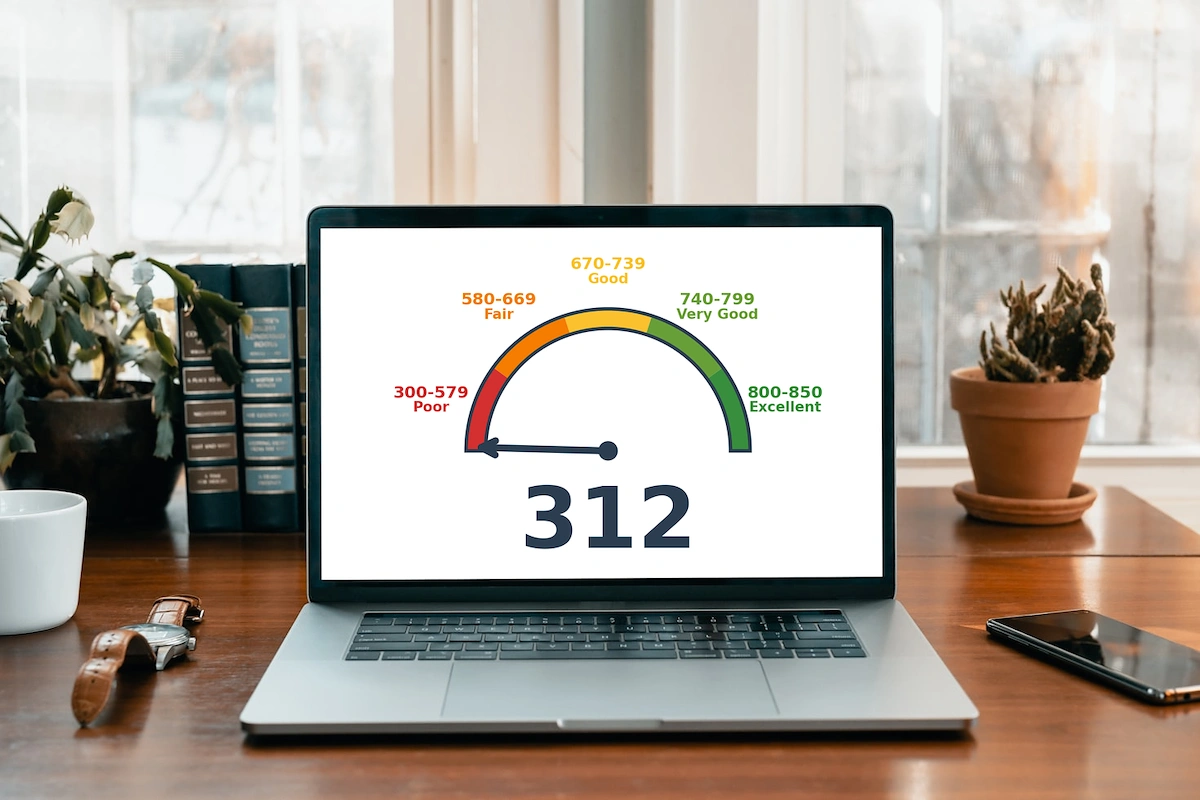
Kudos has partnered with CardRatings and Red Ventures for our coverage of credit card products. Kudos, CardRatings, and Red Ventures may receive a commission from card issuers. Kudos may receive commission from card issuers. Some of the card offers that appear on Kudos are from advertisers and may impact how and where card products appear on the site. Kudos tries to include as many card companies and offers as we are aware of, including offers from issuers that don't pay us, but we may not cover all card companies or all available card offers. You don't have to use our links, but we're grateful when you do!
312 Credit score: What You Need to Know in 2025
July 1, 2025


TL;DR
A 312 credit score is a foundational starting point, offering a clear path toward building a stronger financial profile. This score is categorized as 'Poor' by FICO, which highlights a significant opportunity for improvement.
What Does a 312 Credit Score Mean?
A credit score of 312 places you at the lowest end of the FICO Score range, which spans from 300 to 850. This score falls squarely into the "poor" credit category, the lowest tier defined by credit bureaus. Lenders view scores in this range as a sign of very high risk, often indicating a history of significant financial difficulties, such as defaults, collections, or other serious delinquencies.
Financially, a 312 score presents considerable challenges. Securing new credit—whether a credit card, auto loan, or mortgage—will be extremely difficult. Any offers you do receive will likely come with steep interest rates and unfavorable terms. While this score reflects past struggles, understanding where you stand is the first step. From this point, it is possible to begin the journey of rebuilding your financial standing.
Who Has a 312 Credit Score?
While age is not a direct factor in credit score calculations, data reveals a clear trend of scores increasing with age. This is typically because older individuals have had more time to build a longer credit history and establish a track record of payments. According to 2023 Experian data, the average FICO score breaks down by generation as follows:
- Ages 18-26 (Generation Z): 680
- Ages 27-42 (Millennials): 690
- Ages 43-58 (Generation X): 709
- Ages 59-77 (Baby Boomers): 745
- Ages 78+ (Silent Generation): 760
Credit Cards With a 312 Credit Score
A credit score of 312 is considered very poor, placing you in the lowest tier of creditworthiness. This score signals a significant risk to potential lenders, which means you'll likely face immediate rejection for most conventional credit cards. While securing an unsecured card from a major bank is highly improbable, there are specialized credit-building cards that you might still be able to qualify for.
Kudos offers AI-powered tools like Dream Wallet that analyze your spending habits to find suitable options from a database of nearly 3,000 credit cards. The platform provides personalized recommendations and insights on how different cards might impact your credit score, helping you make an informed decision for your financial situation.
Auto Loans and a 312 Credit Score
A 312 credit score places you in the deep subprime category, which can make securing an auto loan challenging. While you may still find lenders willing to work with you, you should expect to face significantly higher interest rates and less favorable loan terms.
According to a 2025 guide on interest rates, here is a breakdown of average rates for new and used car loans by credit score:
- Super-prime (781-850): 5.25% for new cars and 7.13% for used cars
- Prime (661-780): 6.87% for new cars and 9.36% for used cars
- Non-prime (601-660): 9.83% for new cars and 13.92% for used cars
- Subprime (501-600): 13.18% for new cars and 18.86% for used cars
- Deep subprime (300-500): 15.77% for new cars and 21.55% for used cars
Mortgages at a 312 Credit Score
A 312 credit score is well below the minimum threshold for any mainstream mortgage. According to mortgage requirements, even the most accessible FHA loans require a score of at least 500. This means conventional, FHA, VA, and USDA loans are not an option, as borrowers with scores this low are extremely unlikely to qualify for traditional financing.
The impact of an extremely poor credit score is severe. If you found a rare specialty lender willing to consider your application, you would face punishing terms, including much higher interest rates and fees. Lenders would also likely require a larger down payment, cap your loan amount, and put your finances through intense manual underwriting.
What's in a Credit Score?
Figuring out what goes into your credit score can feel like trying to solve a complex puzzle, but it's primarily based on a handful of key financial habits. The most common factors include:
- Your payment history tracks whether you have paid past credit accounts on time.
- Credit utilization is the percentage of your available credit that you are currently using.
- The length of your credit history considers the age of your oldest account and the average age of all your accounts.
- Having a healthy mix of credit types, such as credit cards and installment loans, can positively impact your score.
- Recent credit inquiries and newly opened accounts can temporarily lower your score.
How to Improve Your 312 Credit Score
Don't be discouraged by a 312 credit score; with consistent, positive financial habits, it's entirely possible to see meaningful improvements. While it takes time, taking the right steps can put you on the path to a healthier credit profile.
- Monitor your credit reports. Regularly checking your reports from all three bureaus helps you spot and dispute any errors that could be unfairly lowering your score. This also gives you a clear roadmap of the negative items you need to address to begin rebuilding.
- Apply for a secured credit card. A secured card requires a cash deposit but is an excellent tool for someone with a low score, as your payments are reported to the credit bureaus. Making small, regular purchases and paying them off on time demonstrates responsible credit management to future lenders.
- Become an authorized user. If you have a trusted friend or family member with excellent credit, being added to their account can add their positive payment history to your file. This can also increase your total available credit, which helps lower your credit utilization ratio.
- Address collection accounts. A score in this range often indicates accounts in collections, which are major negative marks on your report. Contacting the collection agency to negotiate a settlement or a pay-for-delete agreement can be a critical step in stopping the damage.
Using a tool like Kudos can help you manage your cards and monitor your score as you begin your credit improvement journey.

Supercharge Your Credit Cards
Experience smarter spending with Kudos and unlock more from your credit cards. Earn $20.00 when you sign up for Kudos with "GET20" and make an eligible Kudos Boost purchase.
Editorial Disclosure: Opinions expressed here are those of Kudos alone, not those of any bank, credit card issuer, hotel, airline, or other entity. This content has not been reviewed, approved or otherwise endorsed by any of the entities included within the post.




























.webp)
.webp)
.webp)
%20(1).webp)
.webp)


.webp)
.webp)
%20(1).webp)